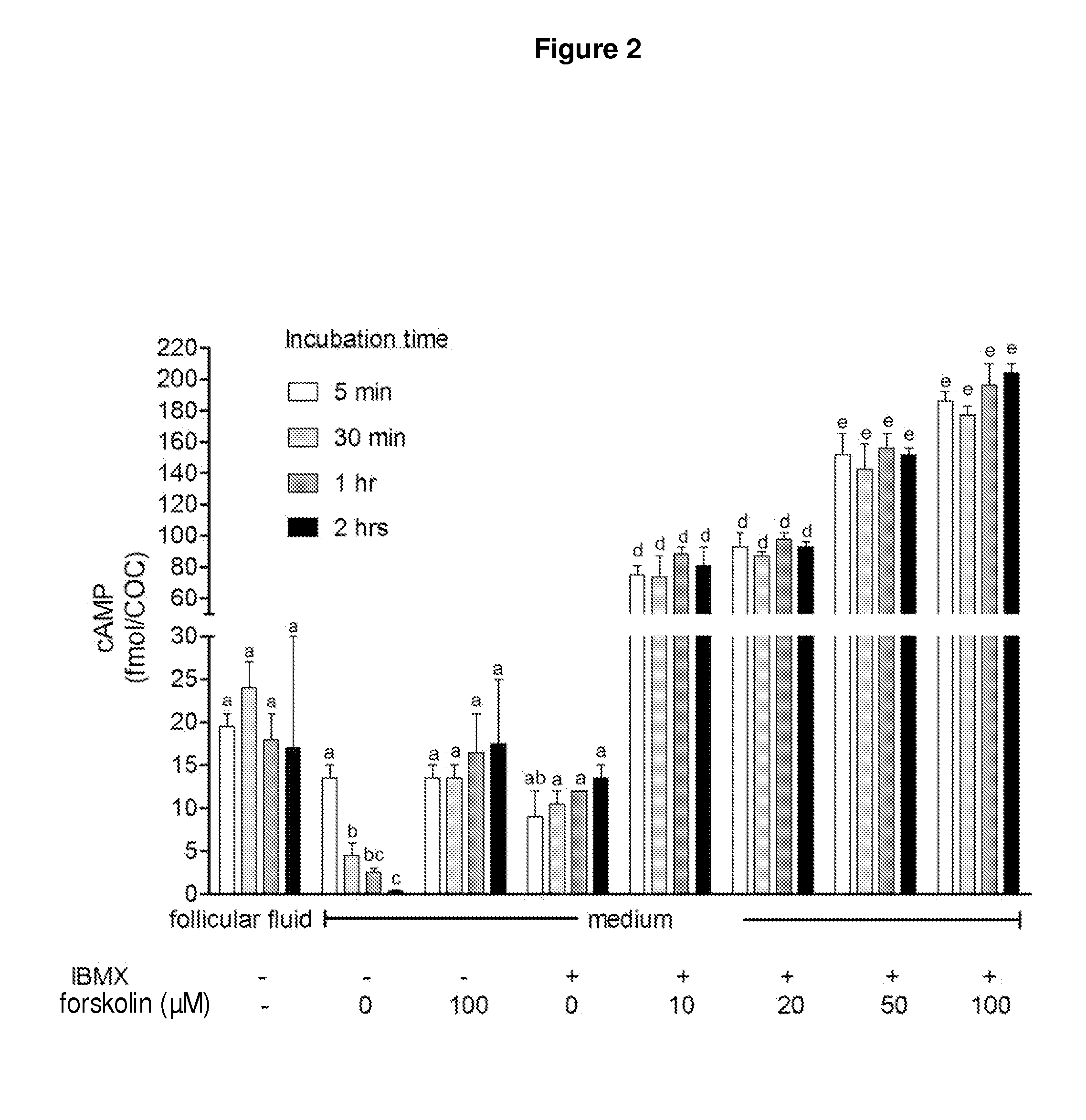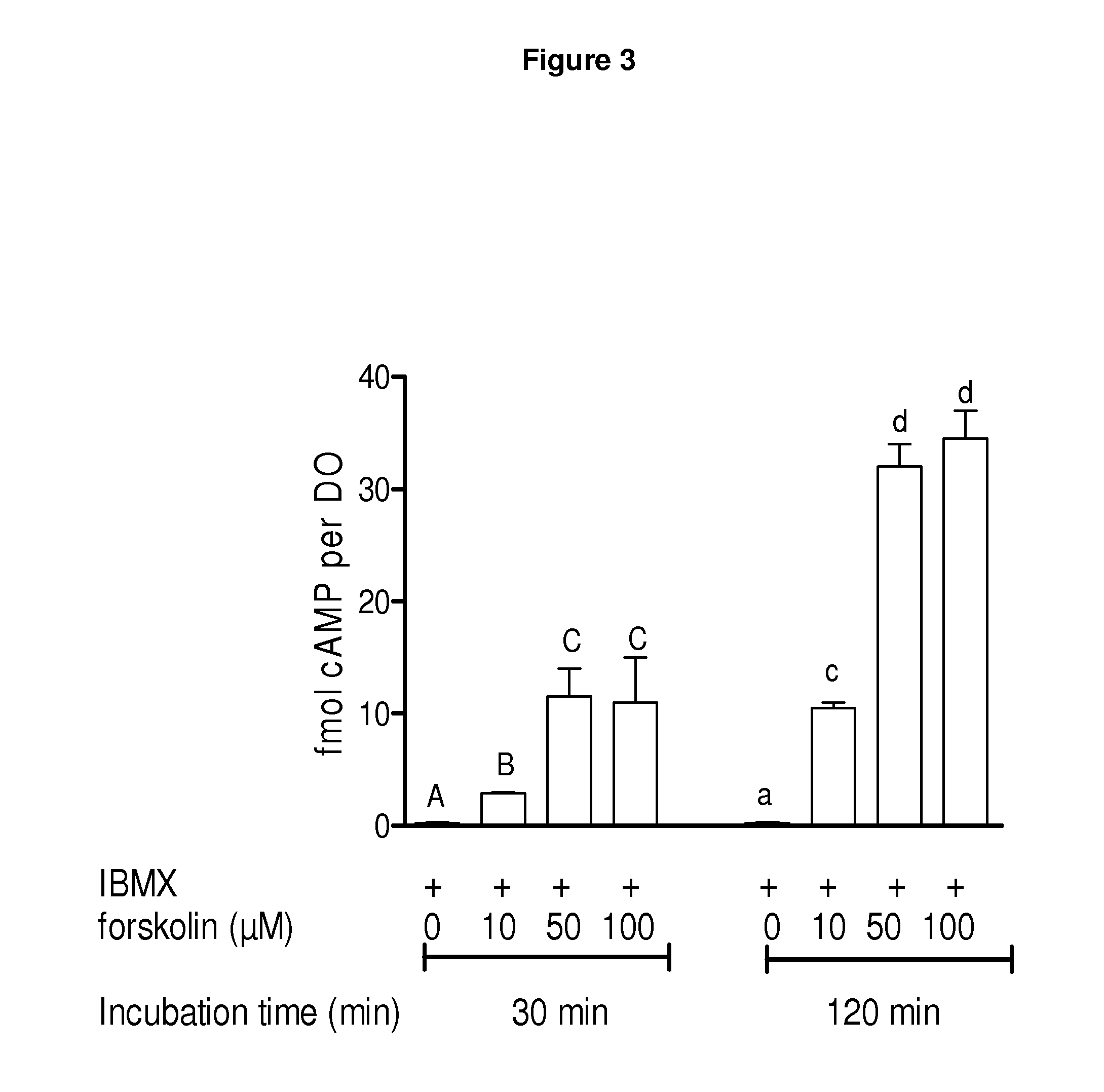Methods for the collection and maturation of oocytes
a technology of oocytes and collection methods, applied in the field of methods for the collection and maturation of oocytes, can solve the problems of reducing the efficiency of ivm relative to ivf in establishing pregnancies and live births, mild ohss and self-limiting, and requiring hospitalization
- Summary
- Abstract
- Description
- Claims
- Application Information
AI Technical Summary
Problems solved by technology
Method used
Image
Examples
example 2
[0205]FIG. 14 shows the results of a comparison between in vivo cAMP concentrations in mouse cumulus-oocyte complexes (COCs) following follicular growth induced by equine chorionic gonadotropin (eCG) and human chorionic gonadotropin (hCG)-induced oocyte maturation (A) compared with cAMP concentrations in in vitro cultured COCs during pre-IVM phase with no cAMP modulators (2 hours which includes COO collection and selection) before oocyte in vitro maturation with no cAMP modulators (B). The data represents the mean cAMP level per COC±SEM of 4 replicates. Each measurement was conducted on 12 COCs.
[0206]The figure shows that there was a significant increase in cAMP concentration in in vivo matured oocytes following the hCG treatment, whereas spontaneously matured in vitro matured oocytes had low levels of cAMP, which fall even further. Such a loss in cAMP with spontaneously matured oocytes appeared to be associated with reduced developmental competence.
example 3
[0207]FIG. 15 shows the effect of increasing doses of FSH to induce meiotic maturation of mouse cumulus-oocyte complexes (COCs) matured in the presence of the type-3 PDE inhibitor (cilostamide; 1 μM (A) or 0.1 μM (B)). In this example, the basic medium used for mouse oocyte collection (without cyclic AMP modulators) was a HEPES-buffered α-Minimal Essential Medium (HEPES-MEM), supplemented with 3 mg / ml BSA, 1 mg / ml fetuin and 1.0 or 0.1 μM cilostamide, depending on what the concentration of cilostamide was used for IVM. COCs were held in the collection medium for approximately 30 minutes. For IVM, the basic maturation medium was a bicarbonate buffered α-Minimal Essential Medium (MEM) supplemented with 3 mg / ml BSA, 1 mg / ml fetuin and incubated at 37° C. in humidified 6% CO2 in air. Variable FSH concentrations were used. COCs were cultured in MEM+cilostamide (1 μM (A) or 0.1 μM (B)) and increasing doses of FSH (0.01-200 mlU) for 24 hours of IVM. Oocytes were then fixed and assessed for...
example 4
[0209]FIG. 16 shows the effect of cAMP modulators during both pre-IVM and IVM phases on oocyte meiotic resumption. In this example, the basic medium used for mouse oocyte collection (without cyclic AMP modulators) was a HEPES-buffered α-Minimal Essential Medium (HEPES-MEM), supplemented with 3 mg / ml BSA, 1 mg / ml fetuin. For IVM, the basic maturation medium was bicarbonate buffered α-Minimal Essential Medium (MEM) supplemented with 3 mg / ml BSA, 1 mg / ml fetuin and incubated at 37° C. in humidified 6% CO2 in air. COCs were aspirated and selected in either collection medium supplemented with 0.1 μM cilostamide or collection medium supplemented with 50 μM forskolin (FSK); and 50 μM IBMX for 1 hour. COCs were then matured in maturation medium in the presence of 100 mlU FSH and 0.1 μM cilostamide for 18-26 hours. Oocytes were then fixed and assessed for meiotic progression at each time point. A mean number of 45 oocytes were used in each treatment group and time-point from four replicate e...
PUM
| Property | Measurement | Unit |
|---|---|---|
| diameter | aaaaa | aaaaa |
| concentration | aaaaa | aaaaa |
| time | aaaaa | aaaaa |
Abstract
Description
Claims
Application Information
 Login to View More
Login to View More - R&D
- Intellectual Property
- Life Sciences
- Materials
- Tech Scout
- Unparalleled Data Quality
- Higher Quality Content
- 60% Fewer Hallucinations
Browse by: Latest US Patents, China's latest patents, Technical Efficacy Thesaurus, Application Domain, Technology Topic, Popular Technical Reports.
© 2025 PatSnap. All rights reserved.Legal|Privacy policy|Modern Slavery Act Transparency Statement|Sitemap|About US| Contact US: help@patsnap.com



